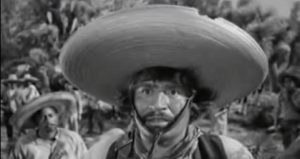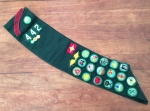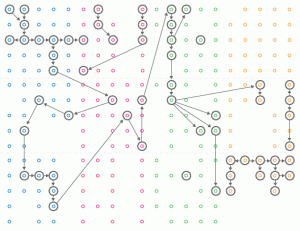Unlike the bandits in The Treasure of the Sierra Madre, it looks maybe we do need some badges.
Week #5 of the History and Future of (Mostly) Higher Education MOOC focused on innovations in pedagogy and assessment. As part of our study this week, we learned about the use of badges in education – and I’ve been thinking about them ever since. I have very fond memories of the badges I earned as a Brownie and a Girl Scout. There was a well-worn Girl Scout Manual, listing each of the possible badges one might earn (one badge per page) along with a description of what had to be done to earn them. Each badge entailed arriving at clear evidence of your mastery and many of the them involved a fairly complex project – building, creating, collaborating. Once awarded, the small, circular, cloth badges were sown onto your sash (thanks, Mom) so that you could wear them with pride. When meeting a fellow girl scout for the first time you could instantly find points of connection – “oh, so you’re a swimmer…” or ” you play the piano!” I have a distinct memory of the point at which the number of badges I’d earned meant that my mother had to start sewing them onto the back side of the sash. Some girls had to wear two sashes, like Pancho Villa, to display their collection (I never got there).
But what about badges in education? They’ve been used in gaming and online spaces for awhile now but what if we devised a system of digital badges for learning? As Connie Yowell, Director of Education at MacArthur Foundation, puts it, digital badges are image files with “stuff” in them. A validated indicator of accomplishment. Tokens of trust. If you earn a digital badge, anyone could open it to find out what you did to deserve it. One could examine the metadata associated with the badge as well as the products and artifacts created by the badge-earner. This suggests a way to clearly and systematically communicate one’s abilities and accomplishments with media-rich, tiled portfolios.
In an educational setting badges could be awarded for knowledge as well as skills. Something you earn along the way of getting better at something larger. Since badges are smaller in scope than a certificate, a badging system gives us an opportunity to break assessment down into smaller (more meaningful? formative?) chunks. Perhaps bringing the assessment closer to actual the learning?
In order to make the badges meaningful, a given education community would have to agree on what’s required to earn a badge. I could imagine some very interesting decisions coming out of such conversations in school districts and colleges. What badges could be earned? How would you break down a general chemistry course into a series of badges? Who decides when the badge has been earned? What is the relationship between badges and credentials, degrees, grades? How does the definition of the badges alter the way we structure the learning? It would have to be a rigorous system, grounded in the values of the institution and reflection of the learning objectives that drives their curriculum.
As one substantial step in the right direction, the folks at Mozilla have developed Open Badging to provide a shared infrastructure (software and open technical standards) for creating and sharing badges across the web. Earned badges could be displayed on your web page, your social media profile, your cell phone, your online portfolio, your email signature line.
So, where to get more information? The MacArthur Foundation has led the way with careful thought and funding so their site on digital badges is worth a visit. Cathy Davidson has proposed using a badging system to facilitate peer group feedback in this HASTAC post. Carla Casilli talks about badge pathways in this post on her blog about badge system design (that’s her image in the figure below). UC Davis has devised a badging system for their new undergraduate major in sustainable agriculture and food. Purdue University has devised the Purdue Passport Program, currently in beta – a way to “show what you know”. Educause recently published one of its helpfully succinct “7 Things You Should Know” documents on Badging.
I am warmed by the implied message here that education happens in many different places and forms; that learning happens in a vast range of places – after school programs, online, in the home, mentoring programs, internships, study abroad programs, and on the job. Formal and informal. And isn’t it interesting to consider that the process of earning a badge would give the student a language around their learning, a way to meaningfully talk about what they did, thought, and experienced?
Here’s another intriguing thing to consider – the concept of the badge as a pathway – a sort of breadcrumb trail to show others how you got there and, presumably, how to follow you. Badges could work to make learning visible in a way that a diploma or your GPA just doesn’t. What does an “A” in Geography 101 at Bowling Green State University mean anyway? When you think about it, your diploma or your certificate says more about the institution you attended than it does about you. A badging system would give you an opportunity to tell the story of your education.




Key for credibility and acceptance will be common standards across institutions.
How do we make badges work with the more ephemeral but critical hiring criteria– leadership, humility, collaboration, adaptability, loving to learn– of Google mentioned in Thomas Friedman’s recent NYT column? http://www.nytimes.com/2014/02/23/opinion/sunday/friedman-how-to-get-a-job-at-google.html?WT.mc_id=NYT-E-I-NYT-E-AT-0227-L17&WT.mc_ev=click&nl=el
That’s the interesting thing – the agriculture and food program that Joanna Normoyle and her team at UC Davis developed the badges for is a strongly interdisciplinary, stretching across eight departments. They were motivated to use badges for accreditation primarily because they couldn’t see how conventional grading could address the important skills that had to stretch across disciplines. Not only that, but there is a lot of experiential learning in this program (through field work and internships), so much of the learning will take place outside of the classroom. The skills they are “badging” are things like systems thinking, experimentation and inquiry, understanding values, interpersonal communications, strategic management, civic engagement and personal development – just the kind of things that Tom Friedman highlights in that excellent op ed piece. I would love to get a look at the UCDavis rubrics for those badges, wouldn’t you?
Makes sense. Thanks for the additional explanation and connection. Yes, the rubrics are critical. Of course the more subjective they are the more difficult it is to standardize across multiple same-titled-courses and institutions.
Pingback: Reflections on #FutureEd | Stepping Stones